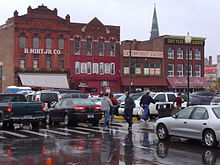| Revision as of 15:37, 29 March 2009 editThomas Paine1776 (talk | contribs)Extended confirmed users, Pending changes reviewers35,556 editsNo edit summary← Previous edit | Revision as of 17:08, 3 May 2009 edit undoBeno1000 (talk | contribs)Pending changes reviewers3,659 editsmNo edit summaryNext edit → | ||
| Line 22: | Line 22: | ||
| }} | }} | ||
| '''Eastern Market''' is a historic commercial district in ], ].It is located approximately one mile (1.6 km) northeast of the city's downtown and is bordered on the south by ], the north by Mack Avenue, the east by St. Aubin St. and the west by the Chrysler Expressway (]). | '''Eastern Market''' is a historic commercial district in ], ]. It is located approximately one mile (1.6 km) northeast of the city's downtown and is bordered on the south by ], the north by Mack Avenue, the east by St. Aubin St. and the west by the Chrysler Expressway (]). | ||
| ==History == | ==History == | ||
Revision as of 17:08, 3 May 2009
United States historic place| Eastern Market Historic District | |
| U.S. National Register of Historic Places | |
| U.S. Historic district | |
 Shed at Eastern Market Shed at Eastern Market | |
| Location | Detroit, Michigan |
|---|---|
| Architect | Smith,Hinchman & Grylls |
| Architectural style | Early Commercial, Late Victorian |
| NRHP reference No. | 78001518 06001330 (boundary increase) |
| Added to NRHP | November 29, 1978 February 01, 2007 (boundary increase) |
Eastern Market is a historic commercial district in Detroit, Michigan. It is located approximately one mile (1.6 km) northeast of the city's downtown and is bordered on the south by Gratiot Avenue, the north by Mack Avenue, the east by St. Aubin St. and the west by the Chrysler Expressway (I-75).
History

The Farmer's Market in Detroit was first opened in 1841 at Cadillac Square in the downtown area. In the 1850s, additional markets were opened on the east side of the city (the present location of Eastern Market) and the west side at the corner of Michigan and Trumball, the then future site of Tiger Stadium. In the beginning, the eastern market was devoted to hay and wood sales, but in 1891, sales sheds were built and the Farmer's Market was moved from Cadillac Square to its present location and renamed Eastern Market.
The Eastern Market grew through the following decades, and additional sheds were constructed in 1922 and 1929. Following World War II, more wholesalers and food processors moved into the area, and Eastern Market developed into an important hub for the wholesale food distribution industry.
Present Use
The market presently covers 43 acres (17 ha) and is the largest historic public market district in the United States. Eastern Market is a selling point for a wide variety of produce, meat, spice and other products. It is particularly busy on Saturdays, when farmers tend to bring in their poultry and livestock, along with fresh produce, for sale.
Notes
- ^ "National Register Information System". National Register of Historic Places. National Park Service. 2007-01-23.
- ^ History of Detroit's Historic Eastern Market: 117 Years of Service to Detroiters Since 1891 by Ed Deeb from EasternMarket.org
- Detroit Eastern Market
References and further reading
- Hill, Eric J. and John Gallagher (2002). AIA Detroit: The American Institute of Architects Guide to Detroit Architecture. Wayne State University Press. ISBN 0-8143-3120-3.
- Meyer, Katherine Mattingly and Martin C.P. McElroy with Introduction by W. Hawkins Ferry, Hon A.I.A. (1980). Detroit Architecture A.I.A. Guide Revised Edition. Wayne State University Press. ISBN 0-8143-1651-4.
{{cite book}}: CS1 maint: multiple names: authors list (link)
External links
 | ||
| U.S. National Register of Historic Places | |
|---|---|
| Topics | |
| Lists by state |
|
| Lists by insular areas | |
| Lists by associated state | |
| Other areas | |
| Related | |
